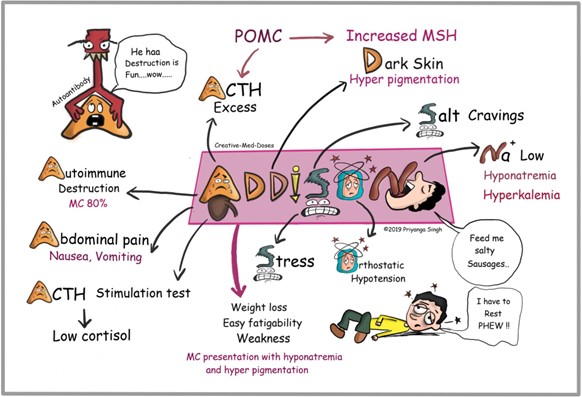A client with Addison's disease becomes weak, confused, and dehydrated following the onset of an acute viral infection. The client's laboratory values include: sodium 129 mEq/L (129 mmol/L), glucose 54 mg/dl (2.97 mmol/L) and potassium 5.3 mEq/L (5.3 mmol/L).
When reporting the findings to the healthcare provider, the nurse anticipates a prescription for which intravenous medication?
Reference Ranges
- Sodium [Reference Range: Adult 136 to 145 mEq/L (136 to 145 mmol/L)
- Glucose (Reference Range: 0 to 50 years: 74 to 106 mg/dl. (4.1 to 5.9 mmol/L))
- Potassium [Reference Range: 3.5 to 5.0 mEq/L (3.5 to 5.0 mmol/L)
Broad spectrum antibiotic.
Regular insulin.
Hydrocortisone.
Potassium chloride.
The Correct Answer is C
The client with Addison's disease is experiencing weakness, confusion, and dehydration, which can be indicative of an adrenal crisis. The low sodium level (129 mEq/L) and low glucose level (54 mg/dl) further support this suspicion. An acute viral infection can trigger an adrenal crisis in individuals with Addison's disease.

Intravenous hydrocortisone, a glucocorticoid, is the treatment of choice for managing an adrenal crisis. It helps to replenish cortisol levels and stabilize the client's condition.
Hydrocortisone helps in restoring the body's stress response and regulating electrolyte and glucose levels.
A broad-spectrum antibiotic may be necessary if there is evidence of a bacterial infection, but it does not directly address the symptoms associated with Addison's disease.
Regular insulin is used for managing high blood glucose levels in conditions such as diabetes, but in this case, the client has low glucose levels, so insulin is not the appropriate intervention.
Potassium chloride is a medication used to treat low potassium levels (hypokalemia), but the client's potassium level is within the reference range (5.3 mEq/L). Therefore, potassium chloride is not indicated in this situation.
Nursing Test Bank
Naxlex Comprehensive Predictor Exams
Related Questions
Correct Answer is D
Explanation
The correct answer is choiced. Children usually resume their toileting behaviors when they leave the hospital.
Choice A rationale:
While it is true that hospitalization can be stressful for preschoolers, providing diapers may not be necessary. Regression in toileting is often temporary and related to the stress of the hospital environment.
Choice B rationale:
Initiating a retraining program immediately after returning home may not be necessary. Most children will naturally resume their previous toileting behaviors once they are back in a familiar and less stressful environment.
Choice C rationale:
Bringing a potty chair from home can be helpful in some cases, but it is not always practical or necessary. The child is likely to resume normal toileting behaviors once they are back in their usual environment.
Choice D rationale:
This is the correct answer because children often regress in their toileting behaviors due to the stress and unfamiliarity of the hospital environment.Once they return home, they typically resume their previous toileting habits.
Correct Answer is ["A","B","C","E"]
Explanation
A) Correct- Assessing the child's pulse helps determine their cardiac status and whether they have a detectable heartbeat. This information is essential for deciding the appropriate interventions.
B) Correct- Placing a cervical collar is necessary if there is any suspicion of cervical spine injury due to the fall or submersion. This action helps stabilize the neck and prevent further damage to the spine.
C) Correct- Checking for open wounds is important to assess for potential sources of bleeding or infection that may require immediate attention.
D) Incorrect- While child safety is important, the immediate priority in this situation is assessing and stabilizing the child's medical condition. Child protective services may be involved later if there are concerns about the circumstances surrounding the incident.
E) Correct- Assessing the airway is of utmost importance to ensure that the child can breathe. In cases of near-drowning, ensuring a clear airway is crucial for oxygenation.
F) Incorrect- While establishing intravenous access may be important for certain interventions, it is not one of the immediate priorities in this situation. Ensuring the child's airway, breathing, and circulation take precedence.
Whether you are a student looking to ace your exams or a practicing nurse seeking to enhance your expertise , our nursing education contents will empower you with the confidence and competence to make a difference in the lives of patients and become a respected leader in the healthcare field.
Visit Naxlex, invest in your future and unlock endless possibilities with our unparalleled nursing education contents today
Report Wrong Answer on the Current Question
Do you disagree with the answer? If yes, what is your expected answer? Explain.
Kindly be descriptive with the issue you are facing.
